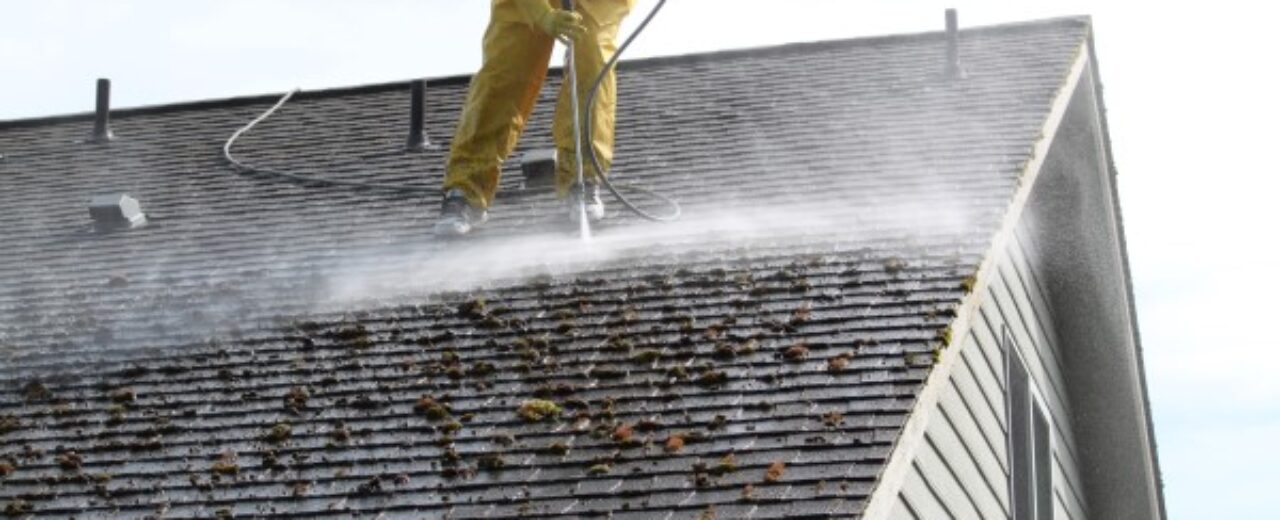
Roofs take a beating. From blazing summer sun ☀️ to pounding rain 🌧️, falling leaves 🍂, bird droppings 🐦, and relentless algae growth — it’s no surprise your roof eventually looks stained, streaky, and downright tired. So naturally, power washing seems like a quick, satisfying fix… but is it safe?
Short answer? It depends.
Power washing your roof can either restore its original beauty — or wreck it completely if done wrong.
In this guide, we’ll cover everything you need to know before you hit your shingles with high-pressure water. Let’s protect your home and get it looking sharp again. 💪🧼
🚫 First Things First: Should You Power Wash Your Roof?
Before anything else, understand this: traditional pressure washing is not safe for most roofs.
High-pressure water can:
- Strip away protective granules from asphalt shingles
- Lift or damage shingles and flashing
- Force water underneath the roof, leading to mold or rot
- Void your roof’s warranty (yes, really)
So, if you’ve been tempted to rent a pressure washer and blast your way to a cleaner roof, stop right there.
✅ Enter: Soft Washing
Instead of using high pressure, soft washing relies on:
- Low-pressure spray (under 500 PSI)
- A blend of water, algaecide, and cleaning detergents
- Gentle rinsing to preserve the roof while cleaning deep
Soft washing is the industry standard for safe roof cleaning — especially on asphalt shingles, tile, and slate.
🏷️ If a cleaning company wants to pressure wash your shingles with 3,000 PSI, run the other way.
Browse Amazon Here For Soft Washing Equipment And Accessories
🧪 What Causes Roof Stains Anyway?
If your roof has long black streaks or dark patches, you’re likely dealing with Gloeocapsa magma — a bacteria that feeds on limestone filler in shingles.
Over time, it spreads across your roof, holding moisture and accelerating wear.
You might also have:
- Moss and lichen, which root into shingles
- Algae, which thrives in humid or shaded areas
- Debris buildup, like leaves or twigs that hold moisture
Soft washing doesn’t just remove the stains — it kills the bacteria and spores causing them. 🧫✨
🛠️ What Roof Types Can Be Soft Washed?
Here’s a quick guide:
| Roof Material | Safe for Soft Wash? | Notes |
|---|---|---|
| Asphalt Shingles | ✅ Yes | Most common choice |
| Metal Roofs | ✅ Yes | Rinse thoroughly |
| Tile (Clay or Concrete) | ✅ Yes | Watch for cracks |
| Wood Shake | ⚠️ Caution | Needs gentle care |
| Slate | ✅ Yes | Use proper support and rinse |
| TPO / Rubber Membrane | ⚠️ Check manufacturer | Very surface-sensitive |
Always check your manufacturer’s guidelines, especially if your roof is still under warranty. 📜
🧼 Step-by-Step: How to Soft Wash a Roof Safely
If you’re hiring a pro, make sure they follow these general steps. Doing it yourself? Be extra cautious with height, chemicals, and equipment.
1. Inspection First
- Check for loose or damaged shingles
- Look for moss, lichen, or excessive algae
- Identify areas needing extra care
🔍 If your roof is brittle, crumbling, or leaking — skip the wash and call a roofer first.
2. Prep the Area
- Cover plants, windows, and anything under the roof edge
- Shut off outdoor electrical connections
- Wear protective gear if applying chemical cleaners
🌿 Some roof detergents can harm landscaping, so water plants before and after washing.
3. Apply Cleaning Solution
- Use a sprayer or soft wash system to coat the roof
- Let it sit 15–30 minutes (don’t let it dry completely)
- Watch as stains begin to break down
☁️ No need for force — the chemicals do the hard work.
4. Gentle Rinse
- Rinse with a wide-angle, low-pressure spray
- Start at the top and work down
- Repeat only if necessary
🌊 Never use high pressure. That’s a surefire way to shorten your roof’s lifespan.
⚠️ Common Mistakes to Avoid
Even with soft washing, mistakes can cost you. Watch out for these:
- Using high pressure by accident
- Letting chemical solutions dry out
- Standing directly on fragile tiles or shingles
- Failing to protect landscaping or siding below
- Not rinsing thoroughly, leaving residue behind
If you’re not confident in your setup or footing, leave it to the pros. Roof work is no place to wing it. 🧯
🧽 How Often Should You Clean Your Roof?
The frequency depends on climate and roof type, but a general guideline is:
- Every 2–3 years for humid or shady areas
- Every 4–6 years in drier regions
If you notice dark streaks returning sooner, it’s time to re-treat. Some pros even apply post-wash treatments that prevent algae regrowth for 12–24 months. 🗓️
🧠 Bonus: Prevent Roof Stains in the Future
Want to keep your roof clean for longer? Try these simple prevention tips:
- Trim overhanging branches to reduce shade and debris
- Clean out gutters regularly to reduce water buildup
- Install zinc or copper strips at the roof ridge — rainwater activates them to inhibit algae
- Keep your attic well-ventilated to minimize moisture buildup
🪴 A clean roof is part maintenance, part prevention.
✅ Final Thoughts
Soft washing your roof is one of the best things you can do to:
- Extend your roof’s life
- Improve curb appeal
- Protect your home from moisture-related damage
- Kill harmful bacteria and algae
But only if it’s done right. 💯
Skip the high-pressure temptation, use the right tools and detergents, and consider a pro if your roof is large, steep, or hard to access.
A clean roof isn’t just about looks — it’s about protecting what’s above your head. 🏡🧼
Browse Amazon Here For Soft Washing Equipment And Accessories



